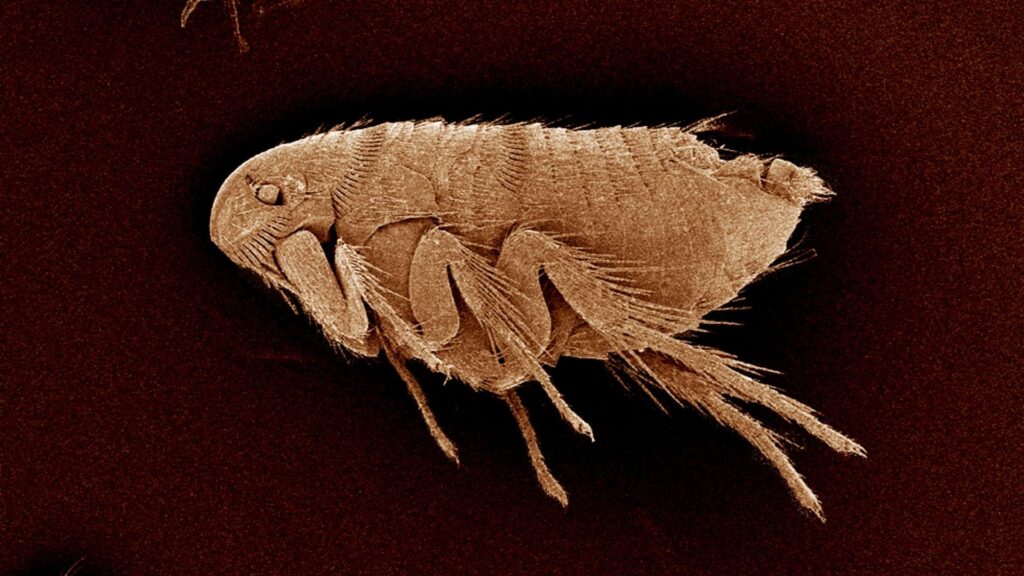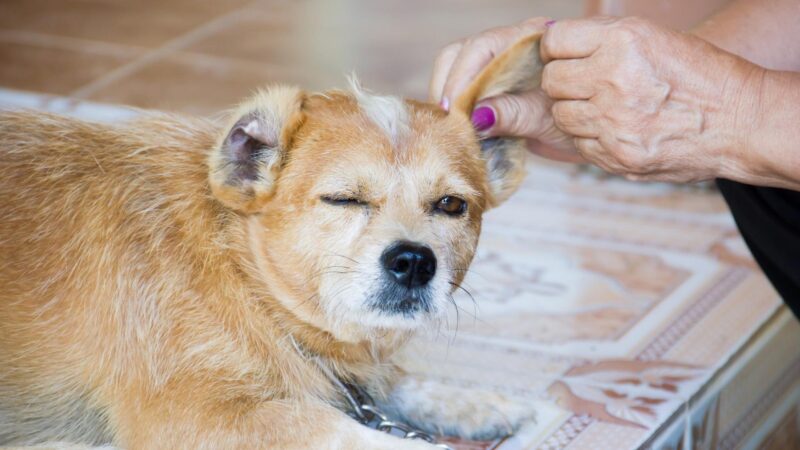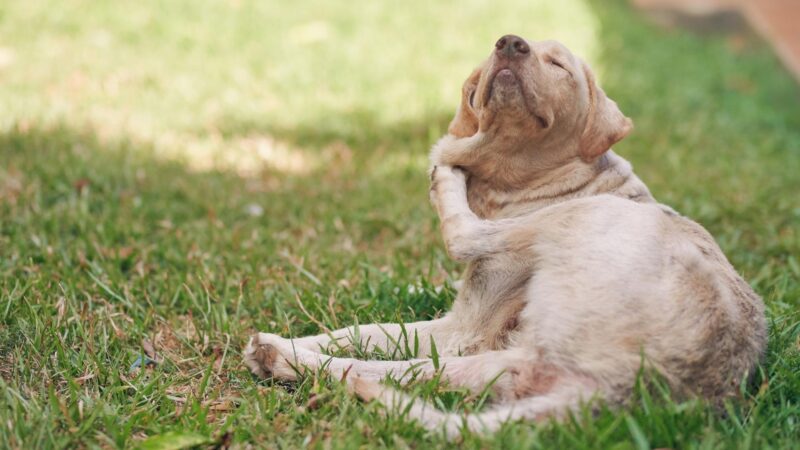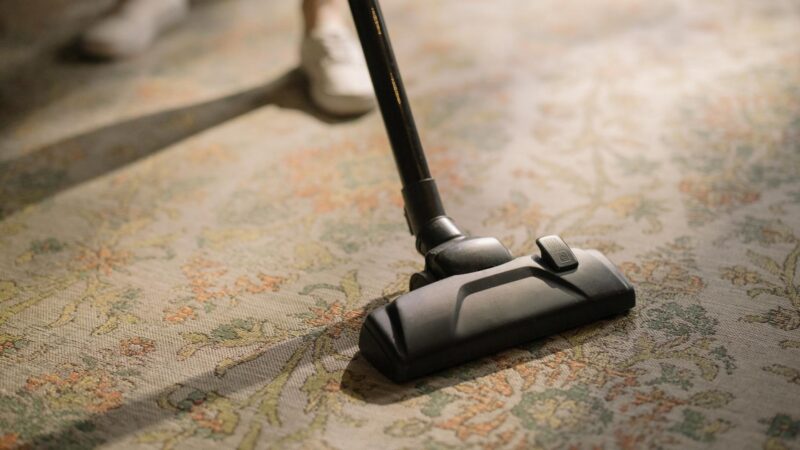Baby fleas are actually flea larvae, which emerge after the eggs hatch. Their favorite diet is adult flea excrement, but they may also feed on various types of organic matter such as dead skin and food particles.
Unlike adults, baby fleas don’t feed on pet blood. They also differ in terms of physical appearance.
What do baby fleas look like? Baby fleas have a small head and chewing mouthparts, but they have no eyes and legs. These worm-like larvae are usually white and transparent when hungry but will turn black or dark red when full. They are so small that you may need a microscope to observe them very clearly.
Scientifically known as Siphonaptera, there are over 2,000 flea species around the world, with more than 300 of them found in the United States.
However, the most common is the cat flea (Ctenocephalides felis). To know more about fleas, their role as external parasites, and how to get rid of them, read this guide from start to finish.
Table of Contents
The Life Cycle of a Flea

There are four life stages of fleas – egg, larval, pupal, and adult stages. This process is called complete metamorphosis. After mating, the female flea will lay an average of 27 oval, off-white eggs per day.
During their lifetime, fleas can produce around 2,000 eggs, which are laid in pets such as cats and dogs.
Once the eggs hatch, larvae will have a brown head and chewing mouthparts but are legless. Fully grown flea larvae will spin a silk cocoon, where they will remain inactive as pupae.
After 1 to 2 weeks, flea pupae will become adults. Unless they are disturbed, adult fleas may stay inside the cocoon for up to 5 months.
Under ideal conditions, fleas can complete their entire life cycle within 20 to 35 days. Therefore, a single flea can produce 9 to 17 generations in a season.
But despite being mated, she should have a blood meal first before she can lay eggs. Nonetheless, their population may still increase during humid and rainy weather.
How Do Fleas Develop?
If the weather is warm and the relative humidity is high, flea eggs may hatch within two to five days and will turn into worm-like larvae. Otherwise, it may take about 14 days.
Flea eggs are usually deposited onto the hair or skin of the host animals. These eggs are white, oval, dry, and are about 0.5 mm in size.
But because eggs are only on the surface, the animals can easily shake them off. This is why you may see them on carpets, bedding, carpet, rugs, and other items where pets stay most of the time.
Flea larvae should feed before they can go to the pupal stage. Adults will also start to feed after leaving the cocoon.
Adult fleas have thin, dark reddish-brown to black bodies covered with spines. They are about 1/12 to 1/8 inch (2.0 to 3.175 mm.) long. Although wingless, their hind pair of legs are designed for a high and long jump.
Amazingly, an adult flea can jump up to 8 inches (20 cm.) high and 16 inches (40.5 cm) in distance.
How Long Do Fleas Live For?
Once the food source is always available and the weather is favorable for them, adult fleas can live up to 1 year. On average, adult fleas can survive for two months without a blood meal.
But once the weather gets dry and hotter, egg production will be greatly reduced, and they may die of hunger within two to five days only.
How Small Are Baby Fleas?
Newly hatched fleas are about 1/16 inch (1.7 mm.) in length and can grow up to 1/4 inch (6.35 mm.) long. They will molt while passing through three larval stages.
Baby fleas are about 1-2 mm. long during the first stage, 2-3 mm. long during the second stage, and 3-5 mm. long during their third and final larval stage.
Do Baby Fleas Crawl or Jump?
Baby fleas have no legs yet, so they cannot jump. Nevertheless, they can crawl using the tiny bristles on their body and will leave their eggshells. Flea larvae can quickly work their way under rugs, carpets, and pet bedding.
They can also easily squeeze their tiny bodies to hide in small gaps and cracks in floors or walls.
Can You See Newly Hatched Fleas?

You cannot see newly hatched fleas unless there are tons of them in one area. These baby fleas are microscopic and very difficult to spot under the naked eye.
Aside from being very fast in hiding in dark areas, they move around the skin of your pet covered with fur, which makes them even harder to notice.
Can You Feel Fleas Crawling?
You can feel fleas crawling on your skin, especially on your legs, ankles, and feet. They may jump to you from your infested pet and pet bed. If a blood meal is unavailable, fleas will also bite you.
Flea bites on humans result in tiny, discolored bumps, which are very itchy and can cause discomfort and skin irritation.
Can Fleas Live in Human Hair?
Fleas cannot live in human hair, but they may stay there for a while. Unlike animals, humans don’t have sufficient hair for fleas to lay their eggs. In short, fleas cannot reproduce or multiply in human hair.
Nevertheless, they can use humans as means of transportation to their favorite food source, furry animals.
Why Do Fleas Bite?
Fleas bite simply because they feed on blood. But unlike bed bugs, they prefer animals over humans due to the presence of thick hair, where they can freely lay eggs.
But then, fleas can enjoy their lives living in homes even if the owners have no pets at all. For fleas, human blood is a great alternative to animal blood.
How Do Fleas Spread?

Fleas feed on warm-blooded animals such as dogs, cats, raccoons, and rodents. Whether indoors or outdoors, these animals tend to investigate things around them, and fleas use this as an advantage.
Rodents and raccoons also coexist with humans, which is why fleas can also enter a household without cats and dogs.
Since fleas can also live for a long time without feeding, they may stay inside a house while the residents are on vacation. Adult fleas can also remain dormant in cocoons and will patiently wait for their host before they emerge.
This is also why fleas can easily spread inside homes and are very challenging to eliminate.
Will Fleas Go Away on Their Own?
Fleas will not away on their own, especially if they are on healthy hosts. In fact, they will also lay eggs on them and will feed on blood as long as they are there. Once they are disturbed, fleas will only move to another area or host.
The only reason that they will go away is when you forcibly remove or eliminate them.
What Are the Signs of a Flea Infestation?

As mentioned earlier, fleas are excellent jumpers and can easily hide in dark areas. Since they love living under the thick fur of cats and dogs, your pets can give you some clues if there are fleas inside your house.
But whether you have pets or not, here are some signs of a flea infestation you should never ignore:
1. Pets Scratching Excessively
Cats or dogs scratch their fur to remove dirt and to groom themselves. But if you notice that they are scratching, biting, or licking their skin excessively, it could be due to fleas. Once fleas bite, their mouthparts can cause pain on the skin, and their salivary glands release a substance, which causes itchiness and irritation.
2. Pets Losing Hair
Infected pets also lose hair but not directly due to fleas. It is because of the scratching and biting of the animals themselves. Fleas may be on any part of the body, but their favorite areas are around the neck, shoulder blades, base of the tail, and back of the legs. In severe cases, fleas can also be on your pet’s belly.
3. Pets Have Flea Allergy Dermatitis
Aside from wounds that look like raised red dots, multiple flea bites can cause pets to suffer from Flea Allergy Dermatitis (FAD). Also known as flea bite hypersensitivity, this dermatologic disease is the allergic reaction of the skin when fleas take a bite. FAD is common to dogs, but cats may also develop it.
4. Pets With Pale Gums
A single flea can consume blood around 15 times its body weight. So for heavy infestations, pets may gradually lose a significant amount of blood that could lead to anemia. This disease can manifest to your pets by exhibiting pale gums. Gums of pets without fleas are pink, which means red blood cell count is high.
5. Presence of Flea Dirt
Flea dirt is the known term for feces of adult fleas. These specks are black or reddish-black since it is made up of undigested blood from their victims, pets, and humans. If flea dirt is very visible on your pet’s fur, it only means that lots of fleas are already present. You may also see them in carpets, pet bedding, etc.
6. Presence of Adult Fleas
Despite being very small, most adult fleas can still be visible if you will carefully observe the suspected areas. You can see them jumping, especially in areas where your pets love to stay most of the time. If you allow your infected dog to sleep on your bed, fleas can hop into your bed or mattress and will soon bite you.
Can Vacuuming Get Rid of Fleas?

Using a vacuum cleaner is effective in getting rid of fleas, as well as their eggs and larvae. Vacuuming carpets and pet beds can easily get fleas out of them.
Baby fleas will also be forced to leave their cocoons and will get killed. You may also kill fleas on floors, furniture, and other surfaces by vacuuming them.
What Kills Fleas Instantly?
If fleas are on your pet dog, give him CAPSTAR Fast-Acting Oral Flea Treatment for Dogs. For your cat, give her CAPSTAR Fast-Acting Oral Flea Treatment for Cats. One tablet kills fleas within 30 minutes. For infested areas, using a powerful handheld vacuum cleaner will kill all life stages of fleas instantly.
What Do You Do When You Find Fleas?
The biggest challenge in getting rid of fleas is that they may not only be on your pet but also in various areas inside and outside your house. Some fleas also carry pathogens that can cause fleaborne diseases, such as cat scratch disease (CSD). Therefore, here are some things you should do once you see fleas:
- Treat your pets, even those that are not infected. Bathe them thoroughly with pet shampoo and water and inspect every part of their bodies.
- Comb them with flea comb such as Safari Dog Flea Comb.
- For dogs, use a reliable dog flea treatment such as FRONTLINE Plus Flea and Tick Treatment for Dogs.
- For cats, use vet-recommended cat flea treatments such as Advantage II Flea Prevention and Treatment for Large Cats.
- For carpets, carpet powders such as Adams Flea & Tick Carpet Powder kill all life stages of fleas effectively.
- Vacuum every corner of your house, including under the carpets, cabinets, and furniture, as well as wall and floor cracks and crevices.
- Instead of using insecticides to break their life cycle, use insect growth regulators (IGR) such as ZOECON Gentrol Insect Growth Regulator.
- To get rid of fleas outdoors, remove low-hanging vegetation and debris from your garden. Flea eggs and larvae will die once exposed to direct sunlight.
- Treat perimeter fences, outdoor dog houses, and kennels.
- Repeat treatments at least twice within the next 5-10 days.
- To help prevent fleas from attacking your dogs, give them oral treatments such as Capstar Fast-Acting Oral Flea Treatment.
- To help prevent fleas, let them wear safe, odorless flea collars such as Seresto Flea and Tick Collar for Dogs.
- Close entries of attics, basements, and other areas where your pets can get fleas.
- As much as possible, don’t allow your pets to stay outdoors for a long time.
Note:
- Dog products should not be used for cats and vice versa. Read labels properly before using any product, and wear protective gloves while applying it. But more importantly, consult your vet to make sure you are using the right products.
- While treating your pets, it’s best if you also treat your home at the same time.
How to Get Rid of Baby Fleas Naturally?
Bug bombs or foggers are ineffective in killing fleas, while most insecticides cannot kill flea pupae and can harm children and pets.
Flea larvae are small enough to hide through carpet fibers and are generally immune to insecticides. Therefore, here are some natural ways to get rid of baby fleas effectively:
- Vacuum regularly, especially in hot, humid locations where flea larvae love to hide. For better results, sprinkle cornstarch on the area before vacuuming them. Throw the vacuum bag far away from your property.
- Sprinkle Diatomaceous Earth (DE) on pet bedding, carpets, and furniture, and let it sit for several hours. Never apply it directly to your pets and avoid inhaling it.
- Wash all pet bedding and other potentially infected fabrics in hot water, and dry them using a hot dryer.
- If infestation is uncontrollable, throw away the pet bedding and replace it with a new one.
- To kill baby fleas on dogs, use a soap-free dog shampoo such as TropiClean Natural Flea & Tick Shampoo, which is made with essential oils. Please remember that don’t use this product on cats.
- To help kill adult fleas, make a flea trap using soapy water in a shallow dish, along with a light source. Alternatively, use eco-friendly flea traps such as Micnaron Sticky Dome Flea Capture Trap.
Summary
Eradicating fleas is a very complex solution, and no single strategy can do the job. You should start by observing the behavior and daily activities of your pet cats and dogs. Take good care of them, so they can help you in helping them. After all, it is your duty as a responsible pet owner.